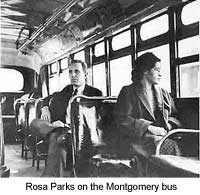Links:
This website gives a brief summary of what harlem renaissance was, it also gives a timeline, biographies, and other links
http://029c28c.netsolhost.com/blkren
This
is the symbol of the National Association for the Advancment of Colored
people(NAACP). They had a lot to do with Harlem Renaissance. The NAACP
published a newspaper for colored people. It was called the Crisis (as
seen below). The NAACP put a lot of their art work , poetry and
photography into the Crisis. It was one of the only ways for colored
people to have their work published.
This website has good info relating to the NAACP.
Langston Hughes was a member of the Harlem Renaissance, here is one of the poems he wrote
The Negro Speaks of the Rivers
I've known rivers:
I've known rivers ancient as the world and older than the
flow of human blood in human veins.
My soul has grown deep like the rivers.
I bathed in the Euphrates when dawns were young.
I built my hut near the Congo and it lulled me to sleep.
I looked upon the Nile and raised the pyramids above it.
I heard the singing of the Mississippi when Abe Lincoln
went down to New Orleans, and I've seen its muddy
bosom turn all golden in the sunset.
I've known rivers:
Ancient, dusky rivers.
My soul has grown deep like the rivers.
Madeline's artist statement
I
did my quilt square with Julia and Abby. Our topic was Harlem
Renaissance. The Harlem Renaissance was a time in reconstruction where
African American artists, musicians, writers, singers, actors, dancers
and others, met up together in Harlem, NY. This was a way that African
American's could express themselves through their passion without being
judged by whites.
In
our quilt square, we divided it into four sections. They each have a
symbol to represent the topic. One is a paint brush to represent the
artists, one is a pencil to represent the writers and poets, one is the
symbol of thearter (happy face, sad face) To represent the actors, the
last one is a note to represent the musicians and dancers. In each one
there is a few faces of people who were involved in that topic. On the
top half there is the Apollo thearter and Cotton Club to represent where
they performed. On the Bottom,There is The CRISIS to represent where
their things were published. In the middle there is a scale with a
question mark representing the question of, are blacks and whites equal
today?
These are some examples of art in Harlem Renaissance

























